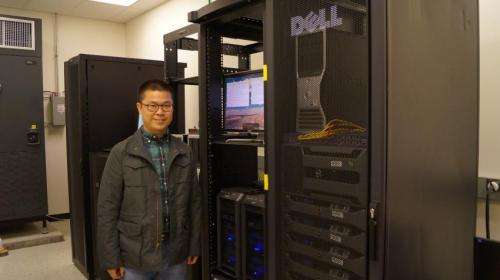New model reveals multiple compositional components of Earth's deep mantle being carried up to the surface

Seeking to better understand the composition of the lowermost part of Earth's mantle, located nearly 2,900 kilometers (1,800 miles) below the surface, a team of Arizona State University researchers has developed new simulations that depict the dynamics of deep Earth. A paper published March 30 in Nature Geoscience reports the team's findings, which could be used to explain the complex geochemistry of lava from hotspots such as Hawaii.
Mantle convection is the driving force behind continental drift and causes earthquakes and volcanoes on the surface. Through mantle convection, material from the lowermost part of Earth's mantle could be carried up to the surface, which offers insight into the composition of the deep Earth. The Earth's core is very hot (~4000 K) and rocks at the core mantle boundary are heated and expand to have a lower density. These hot rocks (also called mantle plumes) could migrate to the surface because of buoyancy.
Observations, modeling and predictions have indicated that the deepest mantle is compositionally complex and continuously churning and changing.
"The complex chemical signatures of hotspot basalts provide evidence that the composition of the lowermost part of Earth's mantle is different from other parts. The main question driving this research is how mantle plumes and different compositional components in Earth's mantle interact with each other, and how that interaction leads to the complex chemistry of hotspot basalts. The answer to this question is very important for us to understand the nature of mantle convection," explains lead author Mingming Li, who is pursuing his Ph.D. in geological sciences.
"Obviously, we cannot go inside of the Earth to see what is happening there. However, the process of mantle convection should comply with fundamental physics laws, such as conservation of mass, momentum and energy. What we have done is to simulate the process of mantle convection by solving the equations which controls the process of mantle convection," says Li.
It has long been suggested that the Earth's mantle contains several different compositional reservoirs, including an ancient more-primitive reservoir at the lowermost mantle, recycled oceanic crust and depleted background mantle. The complex geochemistry of lava found at hotspots such as Hawaii are evidence of this. The various compositional components in hotspot lava may be derived from these different mantle reservoirs. The components could become embedded in and carried to the surface by mantle plumes, but it is unclear how individual plumes could successively sample each of these reservoirs.
Joined by his advisor Allen McNamara, geodynamicist and associate professor in Arizona State University's School of Earth and Space Exploration, and seismologist and SESE professor Ed Garnero, Li and his collaborators' numerical experiments show that plumes can indeed carry a combination of different materials from several reservoirs.
According to the simulations, some subducted oceanic crust is entrained directly into mantle plumes, but a significant fraction of the crust—up to 10%—enters the more primitive reservoirs. As a result, mantle plumes entrain a variable combination of relatively young oceanic crust directly from the subducting slab, older oceanic crust that has been stirred with ancient more primitive material and background, depleted mantle. Cycling of oceanic crust through mantle reservoirs can therefore explain observations of different recycled oceanic crustal ages and explain the chemical complexity of hotspot lavas.
"Our calculations take a long time – more than one month for one calculation – but the results are worth it," says Li.
More information: Chemical complexity of hotspots caused by cycling oceanic crust through mantle reservoirs, DOI: 10.1038/ngeo2120
Journal information: Nature Geoscience
Provided by Arizona State University



















